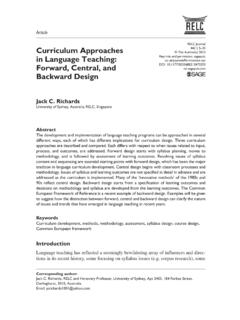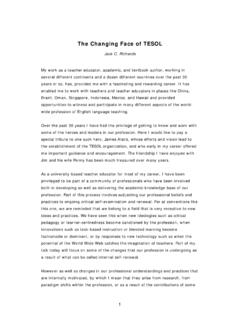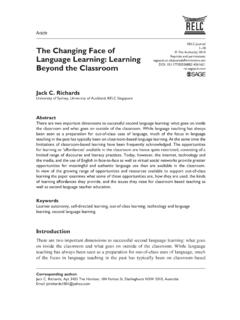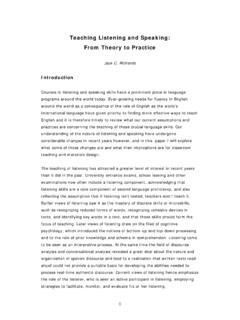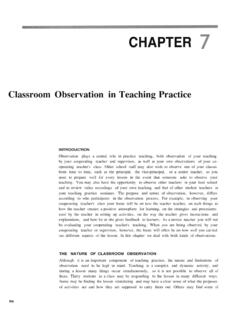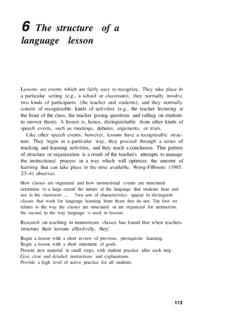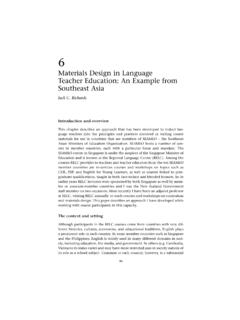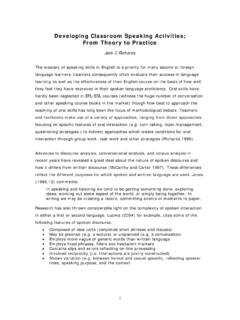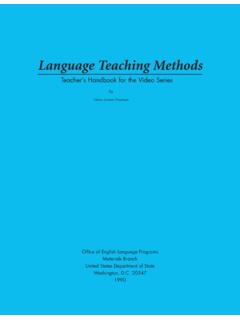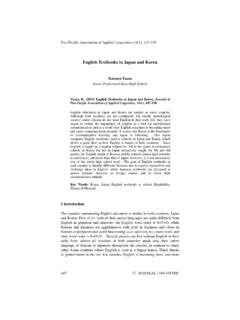Transcription of Communicative Language Teaching Today
1 CommunicativeLanguage TeachingTo d ayJack C. RichardsCAMBRIDGE UNIVERSITY PRESSC ambridge, New York, Melbourne, Madrid, Cape Town, Singapore, S o PauloCambridge University Press32 Avenue of the Americas, New York, NY 10013-2473, Cambridge University Press 2006 This book is in copyright. Subject to statutory exceptionand to the provisions of relevant collective licensing agreements,no reproduction of any part may take place withoutthe written permission of Cambridge University Language Teaching Today is distributed with permission from SEAMEO Regional Language Centre and is part of the Portfolio series by SEAMEO Regional Language Centre which holds the copyright to this published 2006 Printed in the United States of AmericaISBN-13 978-0-521-92512-9 paperbackBook layout services: Page Designs International Table of Contents Introduction 1 1 What Is Communicative Language Teaching ?
2 2 2 The Background to CLT 6 3 Classroom Activities in Communicative Language Teaching 14 4 Current Trends in Communicative Language Teaching 22 5 Process-Based CLT Approaches Content-Based Instruction and Task-Based Instruction 27 6 Product-Based CLT Approaches Text-Based Instruction and Competency-Based Instruction 36 Conclusions 45 References 46 Communicative Language Teaching Today 1 IntroductionThe ever-growing need for good communication skills in english has created a huge demand for english Teaching around the world. Millions of people Today want to improve their command of english or to ensure that their children achieve a good command of english . And opportunities to learn english are provided in many different ways such as through formal instruction, travel, study abroad, as well as through the media and the Internet.
3 The worldwide demand for english has created an enormous demand for quality Language Teaching and Language Teaching materials and resources. Learners set them-selves demanding goals. They want to be able to master english to a high level of accuracy and fluency. Employers, too, insist that their employees have good english Language skills, and fluency in english is a prerequisite for success and advancement in many fields of employment in Today s world. The demand for an appropriate Teaching methodology is therefore as strong as this booklet we will examine the methodology known as commu-nicative Language Teaching , or CLT, and explore the assumptions it is based on, its origins and evolution since it was first proposed in the 1970s, and how it has influenced approaches to Language Teaching Today .
4 Since its inception in the 1970s, CLT has served as a major source of influence on Language Teaching practice around the world. Many of the issues raised by a Communicative teach-ing methodology are still relevant Today , though teachers who are relatively new to the profession may not be familiar with them. This booklet therefore serves to review what we have learned from CLT and what its relevance is Communicative Language Teaching Today 1 What Is Communicative Language Teaching ?Perhaps the majority of Language teachers Today , when asked to identify the methodology they employ in their classrooms, mention Communicative as the methodology of choice. However, when pressed to give a detailed account of what they mean by Communicative , explanations vary widely.
5 Does com-municative Language Teaching , or CLT, mean Teaching conversation, an absence of grammar in a course, or an emphasis on open-ended discussion activities as the main features of a course? What do you understand by Communicative Language Teaching ?Task 1 Which of the statements below do you think characterizes Communicative Language Teaching ? 1. People learn a Language best when using it to do things rather than through studying how Language works and practicing rules. 2. Grammar is no longer important in Language Teaching . 3. People learn a Language through communicating in it. 4. Errors are not important in speaking a Language . 5. CLT is only concerned with Teaching speaking. 6. Classroom activities should be meaningful and involve real communication.
6 7. Dialogs are not used in CLT. 8. Both accuracy and fluency are goals in CLT. 9. CLT is usually described as a method of Language Teaching can be understood as a set of prin-ciples about the goals of Language Teaching , how learners learn a Language , the kinds of classroom activities that best facilitate learning, and the roles of teach-ers and learners in the classroom. Let us examine each of these issues in Goals of Language TeachingCommunicative Language Teaching sets as its goal the Teaching of communica-tive competence. What does this term mean? Perhaps we can clarify this term by first comparing it with the concept of grammatical competence. Grammatical Communicative Language Teaching Today 3competence refers to the knowledge we have of a Language that accounts for our ability to produce sentences in a Language .
7 It refers to knowledge of the building blocks of sentences ( , parts of speech, tenses, phrases, clauses, sen-tence patterns) and how sentences are formed. Grammatical competence is the focus of many grammar practice books, which typically present a rule of gram-mar on one page, and provide exercises to practice using the rule on the other page. The unit of analysis and practice is typically the sentence. While gram-matical competence is an important dimension of Language learning, it is clearly not all that is involved in learning a Language since one can master the rules of sentence formation in a Language and still not be very successful at being able to use the Language for meaningful communication. It is the latter capacity which is understood by the term Communicative competence includes the following aspects of lan-guage knowledge.
8 Knowing how to use Language for a range of different purposes and functions Knowing how to vary our use of Language according to the setting and the participants ( , knowing when to use formal and informal speech or when to use Language appropriately for written as opposed to spoken communication) Knowing how to produce and understand different types of texts ( , narratives, reports, interviews, conversations) Knowing how to maintain communication despite having limitations in one s Language knowledge ( , through using different kinds of communication strategies)Task 2 Consider the following sentences that are all requests for someone to open a door. Imagine that the context is normal communication between two friends. Check if you think they conform to the rules of grammatical competence (GC), Communicative competence (CC), or both.
9 GC CCPlease to opens door. ; ;I want the door to be opened by you. ; ;Would you be so terribly kind as to open the door for me? ; ;Could you open the door? ; ;To opening the door for me. ; ;Would you mind opening the door? ; ;The opening of the door is what I request. ; ;4 Communicative Language Teaching TodayHow Learners Learn a LanguageOur understanding of the processes of second Language learning has changed considerably in the last 30 years and CLT is partly a response to these changes in understanding. Earlier views of Language learning focused primarily on the mastery of grammatical competence. Language learning was viewed as a process of mechanical habit formation. Good habits are formed by having students produce correct sentences and not through making mistakes.
10 Errors were to be avoided through controlled opportunities for production (either written or spoken). By memorizing dialogs and performing drills, the chances of making mistakes were minimized. Learning was very much seen as under the control of the recent years, Language learning has been viewed from a very differ-ent perspective. It is seen as resulting from processes such as: Interaction between the learner and users of the Language Collaborative creation of meaning Creating meaningful and purposeful interaction through Language Negotiation of meaning as the learner and his or her interlocutor arrive at understanding Learning through attending to the feedback learners get when they use the Language Paying attention to the Language one hears (the input)
